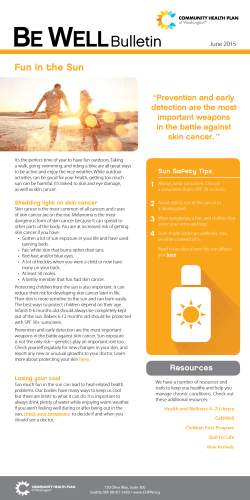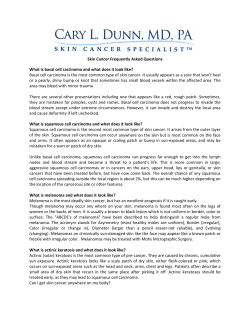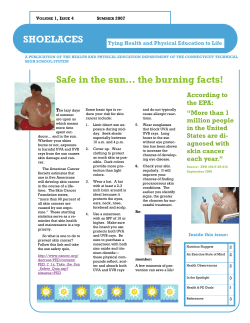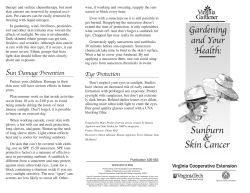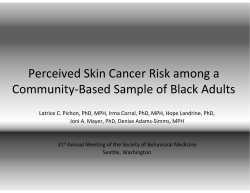
skin cancer Skin cancer What are the
skin cancer How to be SunSmart Skin cancer facts What are the different types? Skin cancer is the most common cancer in the UK and the number of people who get it is increasing. Skin cancer is caused by UV radiation from the sun.The greater your exposure, the higher your risk. Most skin cancers could be prevented by protecting ourselves from the sun’s damaging rays. There are two main types of skin cancer, malignant melanoma and non-melanoma skin cancer. This leaflet contains information about different types of skin cancer and how you can guard against them. What causes skin cancer? Skin cancer develops when genes in skin cells are damaged by ultraviolet radiation. Most skin cancers are the result of excessive exposure to the sun. Many are caused by sun damage in childhood. Who is most at risk? …and reduce your risk People with fair skin that tends to burn or freckle, red or fair hair, or pale eyes are at higher risk. People with black, brown and darker olive complexions have a lower risk of skin cancer. Malignant melanoma (also known as melanoma) is the most serious type of skin cancer. It usually develops in cells in the outer layer of the skin but can spread to other parts of the body and may be fatal. It is vital to detect and treat it early. Melanoma can affect young adults as well as older people. It is the third most common cancer in 15-39 year-olds.You can find out much more about it in our leaflet ‘Malignant melanoma – be a molewatcher for life’. Signs of melanoma See your doctor immediately if… • an existing mole or dark patch is getting larger or a new one is growing • a mole has a ragged outline (ordinary moles are smooth and regular) • a mole has a mixture of different shades of brown and black (ordinary moles may be dark brown but are all one shade) The following signs do not necessarily mean that you have a melanoma, but you should still look out for them. If your mole or dark patch does not return to normal within two weeks, don’t ignore it – see your doctor. • an inflamed mole or one with a reddish edge • a mole that starts to bleed, ooze or crust • a change in sensation of a mole, like a mild itch • a mole that is bigger than all your other moles Non-melanoma skin cancer is the most common and easily treated type of cancer. More than nine out of ten skin cancers are of this type.There are over 59,000 new cases registered each year in the UK. There are two main sorts... • Basal cell cancer is the most common and tends to affect older people. It grows quite slowly and usually starts as a small round or flattened lump that is red, pale or pearly in colour. Sometimes it appears as a scaly, eczema-like patch on the skin. Basal cell cancers usually occur on areas of skin most exposed to the sun such as the head, neck, shoulders and limbs. • Squamous cell cancer is more serious than basal cell cancer as it can spread to other parts of the body if left untreated. Squamous cell cancers appear as persistent red scaly spots, lumps, sores or ulcers, which may bleed easily.They also tend to affect older people and occur most often on the head, neck, hands and forearms. Signs of non-melanoma skin cancer… • a new growth or sore that does not heal within four weeks • a spot or sore that continues to itch, hurt, crust, scab or bleed • persistent skin ulcers that are not explained by other causes What is ultraviolet radiation (UVR)? UVR is invisible and cannot be felt on the skin. It penetrates deeply into our cells, causing changes that can lead to sunburn, skin ageing, eye damage and skin cancer.There are three types of UVR, but only two reach the earth’s surface, UVA and UVB. UVC is filtered out by the ozone layer. • UVA causes skin ageing and is also likely to cause skin cancer • UVB causes redness and sunburn. Exposure to UVB is the major risk factor for all types of skin cancer What affects the amount of UVR? UVR is most dangerous when the sun’s rays are most direct and intense.This is affected by the… • time of year – the highest risk months in the UK are usually May to September. Near the equator, UVR remains high all year round • time of day – UVR is most intense when the sun is high in the sky, around midday • reflection – UVR can be reflected back from surfaces such as snow, sand, light paint, tiles, cement and water.These reflected rays could reach your face even under a hat • cloud cover – you can still burn on a day when there is thin cloud, but heavy cloud does offer some protection • altitude – UVR is greater at higher altitudes Common questions Why is it so important to protect babies and children? Young skin is delicate and easily damaged by the sun. We usually get most of our lifetime’s sun exposure as children and teenagers. Many skin cancers result from sun damage acquired during our early years.Teaching safe sun behaviour to children and their carers helps to protect them right away and sets a good pattern for later life. How can a tan be bad when it makes me feel so much healthier? There is no such thing as a safe tan – it is a sign of damaged skin. A tan today means wrinkled, rough and leathery skin in later years. More importantly, it increases your chance of developing skin cancer. Don’t we need sunshine to be healthy? Our bodies need sunshine to make vitamin D, but most of us get all the sun we need from our daily routine. We don’t generally improve our health or skin by seeking out the sun. Is UV radiation always highest when it’s hottest? No.The sun does not need to feel hot to damage your skin. UV levels are highest around midday, but the maximum temperature often occurs late in the day, when the earth’s surface has had time to warm up.The heat in the sun comes from infra-red rays, not UV rays – you can still burn on cool days. What does SPF mean? SPF stands for Sun Protection Factor, and is a measure of the sunscreen’s ability to filter out UVB rays.The higher the SPF number the more protection you get. Higher factor sunscreens should not be used to increase the amount of time you spend in the sun, but to increase your protection. Are more expensive sunscreens safer? No. Cost is no indication of better protection.You may simply be paying for a brand name. All types are tested and the cheaper brands are just as effective if used properly. What should I look for in a sunscreen? Choose one… • with an SPF of at least 15 – the higher the SPF the better protection • labelled ‘broad spectrum’ (protects against UVA and UVB) • that is water resistant, as it is less likely to wash or be sweated off • with a valid ‘use by’ date (most sunscreens have a shelf life of 2-3 years) How do I use sunscreen properly? • try to apply it 15-30 minutes before going out in the sun – it doesn’t work right away. • apply to clean, dry skin and rub in lightly • use generous amounts (golf ball-size quantities for small children etc) • re-apply every 2 hours or more frequently if washed, rubbed or sweated off • put on before make-up, moisturiser, insect repellent etc Do not store sunscreens in very hot places as extreme heat can ruin their protective chemicals. How safe are sunscreens? Sunscreens are safe for most people, including children, although some people may be allergic to certain types. Sometimes, reaction to the sun itself, such as heat rash, is confused with a sunscreen allergy.You may be more sensitive to sunlight if you are taking certain medicines.Your pharmacist can give you advice. Are fake tans OK? Yes – as far as we know there is no harm in a tan that comes out of a bottle! If you must have a tan, this is a safer way to get one. But fake tans don’t protect you from skin damage or skin cancer. Use of tanning lamps or sunbeds is not safe – it is likely to increase your risk of skin cancer. Perhaps the biggest danger of sunscreens is that they give people a false sense of security. Many people think that if they are wearing sunscreen, they will be safe in the sun for hours.This is not the case. No sunscreen can offer complete protection and you should also use shade and clothing. How to be SunSmart Sunscreen does not offer total protection from the sun’s rays and using it is only one way to reduce your risk of skin cancer. Be SunSmart… S tay in the shade between 11 and 3 the sun is most dangerous in the middle of the day – find shade under umbrellas, trees, canopies or indoors m ake sure you never burn sunburn can double your risk of skin cancer a lways cover up sunscreen in not enough – wear a T-shirt, a wide-brimmed hat and wraparound sunglasses (eyes get sun damaged too) r emember to take extra care with children young skin is delicate, keep babies out of the sun completely t hen use factor 15 sunscreen or higher apply sunscreen generously 15-30 minutes before you go outside (it doesn’t work immediately), and reapply often also • report mole changes or unusual skin growths promptly to your doctor • avoid using sunbeds or tanning lamps Further information Visit Cancer Research UK’s SunSmart website www.sunsmart.org.uk For more about cancer visit our patient information website www.cancerhelp.org.uk click on ‘specific cancers’ then ‘malignant melanoma’ or ‘non-melanoma skin cancer’. If you want to talk in confidence about cancer, call our information nurses. Direct line 020 7061 8355 or freephone 0800 (CANCER) 226 237 or email cancer.info@cancer.org.uk About Cancer Research UK Cancer Research UK is the leading charity dedicated to research on the causes, treatment and prevention of cancer. If you would like to support our work please call 020 7009 8820 or visit our website. Cancer Research UK PO Box 123 London WC2A 3PX 020 7242 0200 www.cancerresearchuk.org www.cancerhelp.org.uk SunSmart June 2003 Registered charity no.1089464
© Copyright 2025

